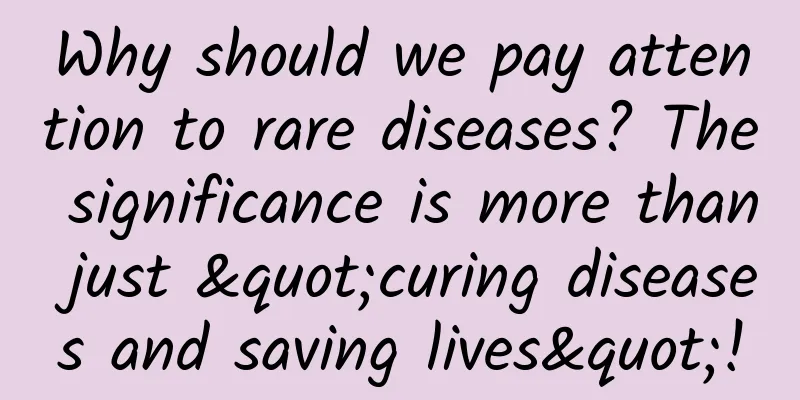Why should we pay attention to rare diseases? The significance is more than just "curing diseases and saving lives"!

|
Today is the 17th International Rare Disease Day. According to statistics, there are more than 7,000 rare diseases known to humans, but only less than 10% of rare diseases have corresponding treatment plans. Most rare diseases are difficult to treat, but many patients face the dilemma of having no medicine to cure them. About 80% of rare diseases are hereditary diseases, and about 50% develop at birth or in childhood. They are often chronic and progressive, involving multiple systems and organs, with complex conditions and difficult diagnosis. How much do you know about rare diseases? What are the causes of rare diseases? Let's learn about rare diseases today. What are rare diseases ? What are the common types? There are about 20 million patients with rare diseases in China. It can be said that rare diseases are not rare . So how is rare disease defined in medicine? The medical definition of a rare disease is actually a definition of the incidence of the disease . The incidence has different definitions in different countries, regions and the world. However, the rarity of rare diseases is relative to common diseases. In fact, the incidence rate of rare diseases is lower than that of common and frequently occurring diseases in our daily lives, and they are concentrated in a small population. Image source: Video screenshot The World Health Organization defines rare diseases as diseases or lesions with a prevalence of between 0.65‰ and 1‰ of the total population . The United States, which has relatively abundant medical resources, defines rare diseases as less than one in 1,000 newborns. But our country currently does not have a special definition for rare diseases. In other parts of the world, there are also definitions based on the total number of patients. For example, rare diseases are defined as those with less than 300,000, less than 100,000, or less than 500,000 patients in a country. In fact, the definition standards of different countries are different. More countries may determine the definition of a rare disease based on the basic standards set by the World Health Organization, or based on the accessibility of medical care, the adequacy of medical resources, and the overall level of medical and health development of the population in each country. This can better coordinate the entire policy, medical care, patient services and other resources, and better serve the rare disease group. What are the types of common rare diseases? The naming of rare diseases is mainly based on the specific system and organ affected by the disease, the corresponding symptoms produced, and the specific substances lacking . But basically any tissue or organ that we can think of that is critical to the human body may correspond to the incidence type of rare diseases . For example, the common diseases we have include "amyotrophic lateral sclerosis (ALS)", "neurofibromatosis", "congenital giant hemorrhoids (hairy kids with hair all over their bodies)", "unique types of hemophilia", "Duchenne muscular dystrophy", etc. Image source: Video screenshot Image source: Video screenshot Although they are all called rare diseases, their symptoms and manifestations vary greatly. Due to the limited number of these diseases and low incidence, they are collectively referred to as rare diseases. What are the influencing factors of rare diseases? There was a previous report that mentioned that when all patients with rare diseases suffer from the disease, it affects not only themselves but also their entire family . If we add up all types of rare diseases and the families of patients, one in every 10 to 20 people in society will be affected by a rare disease or a relative with a rare disease. Therefore, all rare diseases combined have a very heavy burden on society. But no minority group should be ignored, and the same goes for patients with rare diseases. In the analysis and synthesis of many diseases by clinicians, rare diseases are often the last to be discovered or diagnosed, which actually drives our understanding of the diagnosis and differential diagnosis of many diseases. To understand a rare disease, you must have a better understanding of many so-called common or uncommon diseases. After ruling them out, you can get a correct conclusion through some special diagnosis, which will greatly improve your understanding of many diseases. Rare diseases are a research entry point, which can benefit more people with common diseases. So what are the factors that cause rare diseases? Rare diseases are caused by multiple factors. Genetics is the most important factor, and the environment is also one of the influencing factors. In addition, there are rare diseases caused by the combined effects of environment and genes . Image source: Video screenshot For example, the penetrance of neurofibromatosis type I is 100%. What does this mean? All patients with bad genes will have clinical manifestations of this rare disease. However, for many diseases, the penetrance is not necessarily 100%. It may only be in certain environments that the manifestation of this disease is stimulated. In this case, it is possible that the onset of the entire disease is determined by both the environment and genes. Rare diseases and the application of new technologies In the field of rare diseases, there are many new technologies being tested. In the past two years, gene editing has developed very rapidly. This technology has been applied in rare diseases such as hemophilia, amaurosis, and Duchenne muscular dystrophy. In addition to gene editing, there are other new medical technologies such as mRNA technology and protein degradation technology. However, gene editing technology has not yet been widely promoted in the field of rare diseases. First, although the mutated gene is clear , each patient has a different mutation site. If it is customized, the cost for each patient will be very high. Unlike the case where a protein is missing and then supplemented by a gene vector, this method cannot be applied to all patients, especially in cases such as neurofibromatosis, where treatment becomes very difficult because the missing proteins are different. Secondly, the neurofibromatosis gene encodes a neurofibromatosis protein that is extremely large, exceeding the upper limit of the gene fragment that can be accommodated by all current gene therapy vectors. Finally, current vectors used for nervous system gene therapy, including adenovirus and lentivirus, have not yet achieved efficient transfection efficiency. Therefore, all three aspects require further technological breakthroughs. In addition, gene therapy, as an emerging treatment concept, is still in its early stages. With the continuous improvement of technology and vectors, as well as the development of gene therapy models, more diseases may benefit from it. Image source: Video screenshot In addition to gene therapy, immunotherapy, cell therapy, etc. are also the future directions for the treatment of rare diseases. However, which direction is suitable for which rare disease needs to be determined based on the intervention model related to the pathogenesis of the disease. Only in this way can we better adapt to the characteristics of the disease. Therefore, rare diseases require “specific analysis of specific issues”. Currently, there is no one-size-fits-all approach. Only after systematic analysis of every patient, every type and subtype of the disease can we find a suitable method to better enable patients to benefit from the development of new technologies. As a special group, rare patients provide us with a unique perspective on disease treatment, diagnosis, and understanding of the mechanism of disease development. However, the new treatment methods, new drugs and new treatment methods developed from this perspective are usually not limited to such a single rare disease group, but can also bring together a larger and wider population. Song Baoliang, an academician of the Chinese Academy of Sciences, once said: " Studying rare diseases helps us understand and recognize common diseases ." We should regard rare diseases as a window to understand medical development, disease progression, patient psychology, and improve the overall welfare of society. Doctors, scientific research institutions, pharmaceutical companies, the general public, as well as patients suffering from rare diseases and families affected by rare diseases should all actively contribute to rare diseases from their own perspective so that this large group of people with rare diseases, which are not rare, can enjoy more of the benefits of modern scientific and technological development and medical development, and reduce the impact of rare diseases on their lives, health, and social functions. Currently, genetic testing technology can diagnose whether a baby has a rare disease gene mutation . Prenatal screening for high-risk groups for rare diseases can effectively prevent the occurrence of rare diseases. From a national and social perspective, preventing rare diseases through genetic testing, prenatal screening and other means is a low-cost, high-efficiency health strategy. Therefore, adhering to prevention as the main approach, early detection, early intervention, and early treatment are the best ways to prevent and treat rare diseases. Planning and production This film is a work supported by the Science Popularization China Starry Sky Project Produced by: Science Popularization Department of China Association for Science and Technology Producer: China Science and Technology Press Co., Ltd., Beijing Zhongke Xinghe Culture Media Co., Ltd. Creative team丨Dive into science Author: Wang Zhichao, deputy chief physician of Shanghai Ninth People's Hospital Reviewer: Qiao Jiange, Head Nurse of the Geriatric Ward at Shanghai Fifth People’s Hospital |
Recommend
Frequent early awakening may be a disease. What time is considered "early"?
Have you ever had this experience: you woke up be...
How much does it cost to develop the Guangzhou drinking water reminder mini program and the drinking water alarm mini program?
According to statistics, the amount of water a per...
A female scientist who loves to "find faults", she has made "eating fish without spitting out the bones" no longer a dream!
Foodies, are you ready for a new era of food with...
Comprehensive plan for Tik Tok short video marketing and promotion in 2019!
Follow the official account " Operation Uncl...
"91 Ten Articles" - A daily must-read briefing for the new energy vehicle industry (210127)
1. Zhuhai State-owned Assets Supervision and Admi...
I drafted a book for my supervisor, but unexpectedly got a doctoral dissertation...
Some graduate students are not good at finding re...
Guangdiantong advertising, Guangdiantong advertising account opening
In this article, the author will share with you s...
Is there a "sea" in the vast Gobi Desert? It is an "energy supply station" for migratory birds!
In Fuhai County in Altay Prefecture in northern X...
In the era of scene social networking, you need more than instant messaging
In the book "The Coming Era of Scenarios&quo...
Programmer, how serious are you about your work other than writing code?
The company arranged a promotion plan in the midd...
Two directions to help you complete the writing of corporate short video copy!
For our corporate short videos, what is copywriti...
Xishi Tongue: A Millennium Journey from a Beauty Legend to a Delicacy
The sashimi belongs to the phylum Mollusca, class...
20 communication theories that planners must know in 2020
Introduction丨The core of advertising is communica...
Finally, you can watch Douyin on your computer! Detailed experience of Douyin web version
[[407567]] Many netizens want to watch Douyin on ...
Is eating one egg a day good or bad for your health? Here's the latest research!
"Throw away the yolk of the egg, as the yolk...









